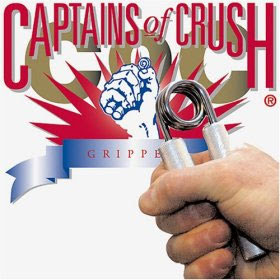
One of the biggest indicators of strength when you first meet someone is when you shake their hand and feel either a vice like grip or a sweaty, limp hand. The strongest grip that I ever came across still remains in my memory as a humbling experience.
I was working on a building site aged sixteen and the site foreman, Tim was renowned for his grip strength. Not knowing this, upon meeting him I offered my hand (I later found that it was common knowledge on-site never to shake his hand) and immediately felt a crushing force unlike anything I'd encountered before or since. He didn't do so in malice, his grip was apparently so strong that he could not gauge it's affect on "normal" people.
I've always had a good grip but this was something else. Which brings me to my point; we all train in different ways for different activities but one type of strength remains universally important and that is grip strength. Lifting heavy loads every day for forty years, it's not difficult to imagine how Tim developed his amazing grip nor is it hard to see the benefits it no doubt brought him at work.
But what for the rest of us? Climbers such as myself require a strong grip as it is our last point of attachment to the rock, it is also generally accepted to be the weakest and therefore the most important. Gymnasts and acrobats need a firm attachment to what they're holding, be it rings, parallel bars or silks. Finally weightlifters require an increasingly strong grip as they improve and lift heavier and heavier weights. I've heard several power lifters complaining that they'd have made that last lift if only their grip was stronger.
So how do we train our grip? It differs from sport to sport; climbers mainly improve through climbing but lifters and athletes whose sport requires a crushing or pinching type grip can benefit from grip enhancers. These are the sprung "gripper" devices that we've all seen and most of us have tried. I began using them years ago but quickly became frustrated with how easy even the hardest store bought grippers were. Then I discovered the Captains of Crush grippers by Ironmind.
Made from aircraft grade aluminium in the USA, these are the worlds toughest grippers. There isn't a man on earth (not even my old site foreman Tim) who could complain about these being too easy; the number four has only been closed by five men in the entire world! Here is a list of the force required to close each:
Guide: 60lbs (27kg)
Sport: 80lbs (36kg)
Trainer: 100lbs (45.5kg)
Number 1: 140lbs (63.6kg)
Number 2: 195lbs (88.6kg)
Number 3: 280lbs (127.2kg)
Number 4: 365lbs (166kg)
There is also a 1.5, 2.5 and 3.5 gripper but the exact force required to crush these is not listed.
I own the "1", "2" and "2.5 "and can close the number 1 for sets of 25-30reps. The number "2" I can close for 5reps and I cannot yet close the 2.5. My target is to close the number "3" and get certified on the Ironmind website. (Only twelve people last year managed to).
As advice on what to go for first; if you consider yourself to have an already very strong grip, start with the "1" or "1.5". I bought the number "1" first and found it to be OK but don't be fooled, most people can't fully close this one. If your grip is average for a guy, get the Trainer and when this becomes easy, you'll be ready for the "1". If you have average strength for a woman, you'll be fine with the Sport or if you're confident, take the Trainer.
At about £22 each, they're not that expensive. Buy them one at a time so that if the one you purchase is too easy/hard, you can get the one above/below and use the original as a warm-up/goal.
As a climber, I didn't feel that training with CoC benefited me at the wall (except on pinch grips on which I now rock!) but it was well worth the investment in training time and money for the simple but satisfying reason that I can now crush an apple into mush!!


